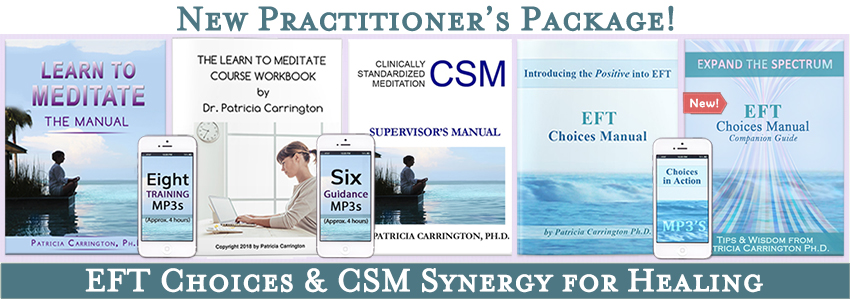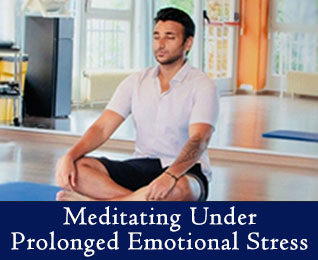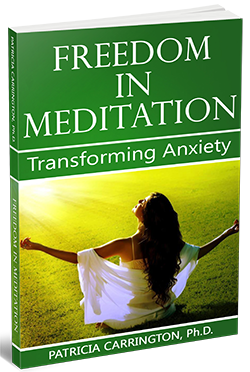During extended periods of stress, it is important to stay calm and meditation is an avenue by which people can achieve calmness. Here are three useful strategies for meditating under prolonged stress
1. Additional Meditation Sessions
While developing and teaching Clinically Standardized Meditation (CSM) years ago, I discovered that additional meditation sessions may be useful when people are under unexpected, continuing emotional stress, such as the sudden illness of a loved one, a financial crisis, or other dire situations.
While the occasional use of mini meditations is helpful for coping with an immediate, specific troubling situation, scheduling extra meditations over strategic and specific periods of time, using CSM, may boost the benefits of meditating during prolonged stressful situations.
For example, a patient of mine who was also a CSM meditator, suddenly experienced a family emergency when his wife was rushed to the hospital, acutely ill. During her stay there, he was challenged by many days of emotional strain waiting for her recovery.
As the days went on, the pressure of serious family decisions and the caring for their children was weighing heavy on him. He soon found himself spontaneously meditating five or six times daily.
Without that intense program of meditation, he reported to me that he would not have endured the strain of that crisis. By increasing his meditating sessions, he managed well, made sound decisions, and was able to plan constructively for his wife’s eventual return home and subsequent recovery.
*Note: Increasing the number of your daily meditation sessions should be handled with careful attention to its effects. However, when properly used, this strategy can be extremely effective.
2. Strategically Timed Meditation Sessions
There were times when CSM students, who found themselves in a state of continual stress, reported that their first meditation of the day had merely scratched the surface, seeming only to skim off the uppermost layer of tension; but no more, which seemed almost futile them.
After waiting a regular half-day before meditating again, as typically instructed in CSM, so much tension had accumulated that the second meditation was also only a mere drop in the ocean, so to speak.
When they altered their meditation schedule, by following the first meditation of the day with another full meditation only one hour, or an hour and a half later, the second meditation had quite a different effect. It was as if the first meditation prepared the ground, and the closely spaced second session ‘took hold’ for a therapeutic effect.
The final and the third meditation, usually coming in the late afternoon or in the evening, also seemed to be more effective under those circumstances. In doing this, the entire day was affected because of the double morning meditations.
After discovering this, I continued to advise students who were under unusually severe stress to do two “double meditations” (a pair of meditations separated by only one to one and a half hours) twice a day. These four strategically placed meditations each day, during a time of intense emotional stress, often work extremely well.
If you choose to try this meditation strategy, it is important to watch how such extra meditations are affecting your behavior, whether or not they lower your alertness, or result in any undue amount of tension-release.
If you experience any issues, the sessions should be reduced in length, or by the number of sessions, until any tension release effects subside.
It is also important to discontinue the extra meditations once the emotional crisis is resolved, so that over-meditating does not develop into a habit.
3. Alternating Meditation with Rest
A striking instance of the use of extra meditations to handle an emotional crisis was reported to me by a psychologist colleague. He found himself in a severe panic because of certain distressing incidents which, while obviously upsetting, could have been better tolerated at another time in his life.
He was experiencing sinking sensations, loss of identity, loss of control, and an eerie sense of unreality. These extreme reactions probably had, at least in part, some physical basis, but this was not clear at the time and it was obvious that some extreme measure had to be employed to break the rising panic.
Since he practiced CSM regularly and was familiar with the strategic use of meditation, he decided to try it to quell his panic. He first withdrew from all stimulation into a darkened room and meditated for twenty minutes, after which he laid down on his bed; half sleeping and half resting. He set his alarm clock, roused himself once more after an hour, and meditated again for twenty minutes.
He continued to do this throughout the day, remaining in a quiet, darkened room and alternating meditation with complete rest on an hourly schedule. As the day proceeded, he experienced immense relief and a feeling as if he was being “pulled out of a black pit” and as though “pieces of a picture puzzle were being put together.”
Although that meditation strategy did not cure his underlying condition – middle-age hormonal changes that later required medical treatment, change of diet, and some psychotherapy – it did serve as an excellent emergency measure.
In effect, it reversed what was a potentially dangerous psychotic breakdown so well that it is a method worth considering for anyone under extreme conditions.
Again, if such a radical measure is used, it should be discontinued once the severe stress reaction to the condition is brought under control.
During this uncertain time of change, worries, and stress, simple, strategic meditation melded into your day just might help you get through it, day by day…
Discover Clinically Standardized Meditation…








